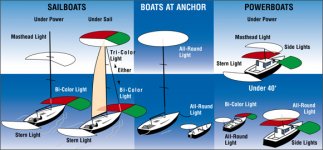Typically, all critical demands such as starter motor, power for primary navigation lights and electronics, bilge pumps, trim tabs, etc. are powered by the “primary” battery. Non-essential and backup systems go to "Secondary" battery.
Certainly no reason why you can't assign the "house" load as "Primary", but then you risk compromising your "Starting" functions.
So the question becomes..........at the end of the day, do you want a fully charged Starting battery and the possibly of a compromise "house" bank (alternator does not meet demand) or.........a fully charged "house" battery with the possibility of being stranded with an under charged starting battery.
First off, I wouldn't want any of my electronics running off of the start battery. To me, the start battery is there for primary underway functions. Like you said, starter motor, power for primary navigation lights, lower trim, and trim tabs. Not much else.
It doesn't really matter which side of the ACR the charge is connected to, the ACR will maintain both battery banks through it's normal operation. However, if it isn't charging the start battery, there is always the combine switch on the battery selector switch to be able to start the engine thus not leaving one stranded.
To help prevent cycling of the relay....A simple solution for boats with a large House battery bank and a relatively small Start battery bank, including many sailboats, is to connect the charging source to the House battery bank (see wiring diagram). This solution works because the Start battery bank is typically smaller and less discharged than the larger House battery bank. When the battery banks are combined for charging, there isn’t a significant drain to lower the system voltage to the disconnect level.
Bluesea
ACR
ACR Myth & Lore:
1- “
An ACR charges the start battery first then isolates it and charges the house” =
FALSE
The ACR does not in any way do this, it is either in parallel or it is not in parallel. Very simple.
2- “An ACR gives priority charging to the start battery” =
FALSE
Please understand that even if you feed charging to the start battery first, which is not advised on a cruising boat with disparately sized banks, 30 seconds of charging is
not charging, even for a minimally depleted start battery. A battery at 99% SOC is in the worst range of charge efficiency. Despite being minimally depleted it still takes a good bit of time to reach an actual 100% SOC again. Each Ah we deliver to the battery, at a high SOC, is not being stored at 100% or even 50% due to the horrible Coulombic efficiencies at high SOC. The
logic delays in the ACR are not there to create “
priority charging” for a start battery or house battery they are there to eliminate
relay-chatter and to help minimize
relay-cycling or on/off/on/off/on/off behavior.
We may just agree to disagree.
 a bit overkill. I'll be starting off with a 2 battery house bank and one starting battery in the system. Currently I have a 55A alternator, plans are to upgrade it to 105A. Plans are to have a 12 position fuse block up front with a common Neg buss and a 6 fuse block with a common Neg buss back by the engine. The engine, trim tabs, lower trim, and the nav lights will all be powered from the starting battery. I'm thinking there are a few too many fuses with this setup. See anything wrong/right with this setup?
a bit overkill. I'll be starting off with a 2 battery house bank and one starting battery in the system. Currently I have a 55A alternator, plans are to upgrade it to 105A. Plans are to have a 12 position fuse block up front with a common Neg buss and a 6 fuse block with a common Neg buss back by the engine. The engine, trim tabs, lower trim, and the nav lights will all be powered from the starting battery. I'm thinking there are a few too many fuses with this setup. See anything wrong/right with this setup? a bit overkill. I'll be starting off with a 2 battery house bank and one starting battery in the system. Currently I have a 55A alternator, plans are to upgrade it to 105A. Plans are to have a 12 position fuse block up front with a common Neg buss and a 6 fuse block with a common Neg buss back by the engine. The engine, trim tabs, lower trim, and the nav lights will all be powered from the starting battery. I'm thinking there are a few too many fuses with this setup. See anything wrong/right with this setup?
a bit overkill. I'll be starting off with a 2 battery house bank and one starting battery in the system. Currently I have a 55A alternator, plans are to upgrade it to 105A. Plans are to have a 12 position fuse block up front with a common Neg buss and a 6 fuse block with a common Neg buss back by the engine. The engine, trim tabs, lower trim, and the nav lights will all be powered from the starting battery. I'm thinking there are a few too many fuses with this setup. See anything wrong/right with this setup?






















